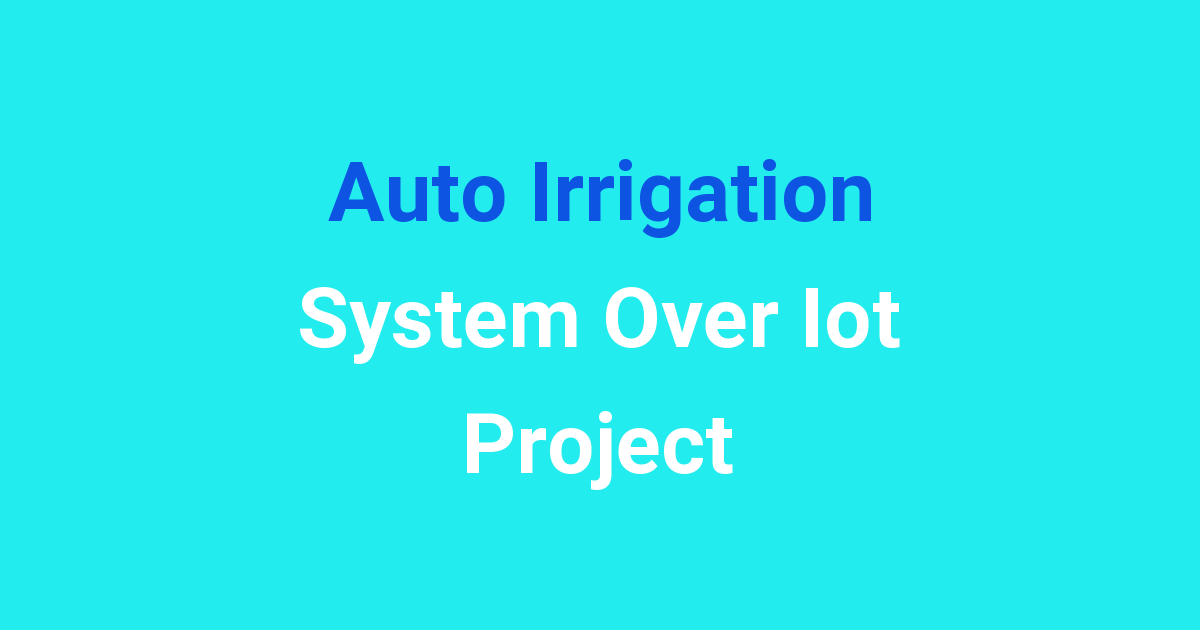Project to develop an Internet of Things (IoT) automated irrigation system.
Auto Irrigation System over IoT Project
Introduction
The Auto Irrigation System is an innovative project that leverages IoT technology to automate the process of watering plants. This project aims to address the issue of manual irrigation, which can lead to over-watering or under-watering of plants. By utilizing IoT devices, this system allows for remote monitoring and control of the irrigation process, thereby improving the efficiency and effectiveness of plant care.
Problem Statement
Manual irrigation systems require constant monitoring and adjustment to ensure that plants receive the appropriate amount of water. This can be time-consuming and labor-intensive, especially for large agricultural fields or gardens. Additionally, manual irrigation systems are often prone to human error, leading to inconsistent watering practices and potential damage to plants.
Existing System
The existing manual irrigation systems rely on human intervention to turn on and off the water supply, as well as adjust the flow of water to each plant or field. This manual process is not only inefficient but also unreliable, as it is dependent on the availability and expertise of the person in charge of watering the plants.
Disadvantages
The disadvantages of the existing manual irrigation system include:
1. Inefficient use of water resources: Manual irrigation systems often lead to over-watering or under-watering of plants, which can result in reduced crop yields and waste of water.
2. Labor-intensive: Constant monitoring and adjustment of the irrigation process require significant time and effort, especially for large agricultural fields or gardens.
3. Human error: Manual irrigation systems are prone to human error, leading to inconsistent watering practices and potential damage to plants.
4. Lack of remote access: Manual irrigation systems do not allow for remote monitoring and control of the irrigation process, making it difficult to adjust watering schedules in real-time.
Proposed System
The proposed Auto Irrigation System over IoT project aims to automate the process of watering plants by using IoT devices to monitor soil moisture levels and control the flow of water to each plant. This system will eliminate the need for manual intervention, allowing for remote monitoring and control of the irrigation process.
Advantages
The advantages of the proposed Auto Irrigation System over IoT project include:
1. Efficient use of water resources: By automatically adjusting the flow of water based on soil moisture levels, this system ensures that plants receive the appropriate amount of water, leading to improved crop yields and reduced water waste.
2. Labor-saving: The automation of the irrigation process eliminates the need for constant monitoring and adjustment, saving time and effort for farmers or gardeners.
3. Accuracy: By using IoT devices to monitor soil moisture levels, this system provides accurate data on the water needs of plants, reducing the risk of over-watering or under-watering.
4. Remote access: The IoT technology allows for remote monitoring and control of the irrigation process, enabling users to adjust watering schedules and settings from anywhere, at any time.
Features
The key features of the Auto Irrigation System over IoT project include:
1. Soil moisture sensors: IoT devices will be used to monitor soil moisture levels and provide real-time data on the water needs of plants.
2. Water flow control: The system will be able to adjust the flow of water to each plant based on the soil moisture levels, ensuring that plants receive the appropriate amount of water.
3. Remote monitoring and control: Users will be able to access the system remotely via a mobile app or web interface, allowing for real-time monitoring and adjustment of watering schedules.
4. Data analytics: The system will collect and analyze data on soil moisture levels, water usage, and plant growth, providing valuable insights for optimizing the irrigation process.
Conclusion
In conclusion, the Auto Irrigation System over IoT project offers a modern and efficient solution to the challenges of manual irrigation systems. By leveraging IoT technology to automate the process of watering plants, this system improves the efficiency and effectiveness of plant care, while also conserving water resources and reducing labor requirements. With its remote monitoring and control capabilities, the proposed system provides users with the flexibility and convenience to manage the irrigation process from anywhere, at any time. Overall, the Auto Irrigation System over IoT project represents a significant advancement in agricultural technology and holds great promise for enhancing crop yields and sustainability in the future.

